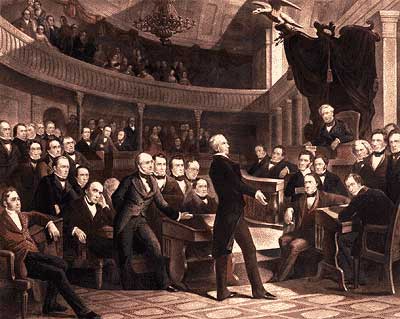
When Henry Clay and Daniel Webster prepared to deliver their plan to save the Union before the U.S. Senate, they would be addressing a collection of very important Americans. Members of the 31st Congress of the United States included some of the most talented and influential leaders of the United States. American Historians have labeled this "The Golden Age of the Senate" because of the collection of talent that was serving. Some of these members were:
Salmon P. Chase from Ohio: would later serve in Lincoln's Cabinet
Jefferson Davis from Mississippi: future President of the Confederacy
Sam Houston from Texas: Former President of Texas, believed in keeping the Union together.
John C. Calhoun from South Carolina: Strong advocate for State's Rights.
Stephen A. Douglas from Illinois: Democratic nominee for President in 1860.
Thomas Hart Benton from Missouri: Jacksonian leader of the Democratic Party advocated westward expansion but spoke out against slavery.
Lewis Cass from Michigan: Jackson's former Secretary of War, later Secretary of State. Advocated General Popular Soverignty for people living in new territories
John Bell from Tennessee: Southern politician who was against the expansion of slavery
Hannibal Hamlin from Maine: Lincoln's first Vice-President
All of these leaders and their Senate counterparts understood that the nation was on the brink of civil war over the issue of expanding slavery.
Below is timeline detailing the passing of the Compromise of 1850:
January 29, 1850: After confiding with Daniel Webster, Henry Clay introduced his Compromise to the U.S. Senate.
February 5th and 6th: Clay addresses the Senate
March 4th: John C. Calhoun's speech against the Compromise of 1850 is read to the Senate
March 7th: Daniel Webster delivers his speech calling for support of Clay's Compromise
March 31st: John C. Calhoun dies
April 17th: Thomas Hart Benton is threatened by Senator Foote from Mississippi on the Senate floor
June 3rd-11: Nine slave states sent delegates to the Nashville Convention to consider a course of action if slavery was banned in the West. Some called for secession.
July 9th: President Taylor, who threatened to veto any legislation that would allow slavery to expand passed away. President Fillmore was open to resolving the issue of slavery with compromise.
September: The Compromise is broken into five sections, and are all passed by both the House and the Senate.
Here are the notes from class.
No comments:
Post a Comment